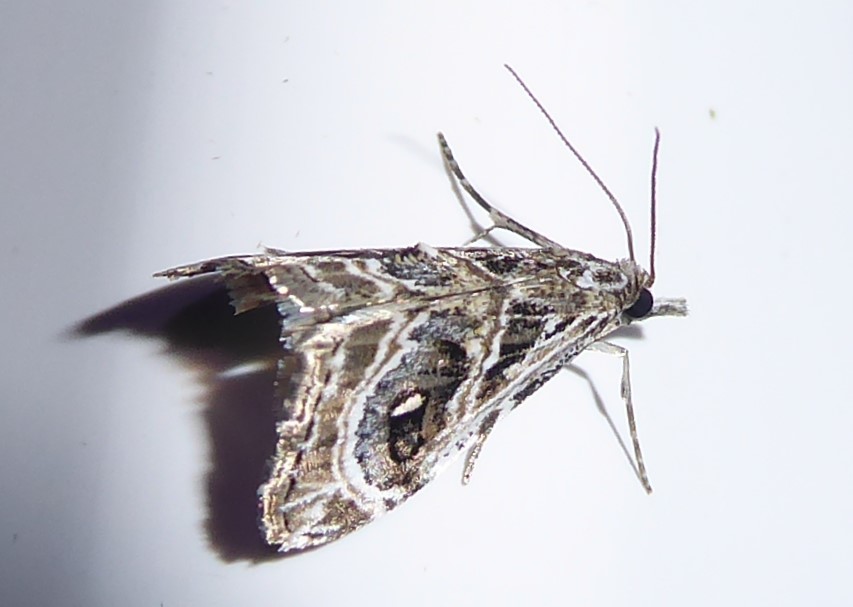Gadira Acerella on:
[Wikipedia]
[Google]
[Amazon]
''Gadira acerella'' is a moth in the family Crambidae. It was first described by Francis Walker. It is endemic to New Zealand and is found throughout the country. The species inhabits native forest from sea level up to subalpine altitudes. Larvae are assumed to feed on lichen or moss. Adults are on the wing from October until March, are active at night and are attracted to light. This species is distinctively patterned and coloured and is said to resemble a bird dropping at rest. The colouring also assists to camouflage the moth when it rests against lichen.
 The life history of this species is currently unknown. Adults are on the wing from October until March. They are active at night and are attracted to light. This species rests with its wings together over its body in a steep V shape. The adults of the species have frequently been observed resting on lichen covered rocks and fences. Hudson was of the opinion that the raised scales and colouring on the forewing caused an at rest adult to resemble a bird dropping. It has also been suggested the raised scales and colouring on the forewing are disruptive and ensures the adult moth blends in with lichens upon which the moth prefers to rest.
The life history of this species is currently unknown. Adults are on the wing from October until March. They are active at night and are attracted to light. This species rests with its wings together over its body in a steep V shape. The adults of the species have frequently been observed resting on lichen covered rocks and fences. Hudson was of the opinion that the raised scales and colouring on the forewing caused an at rest adult to resemble a bird dropping. It has also been suggested the raised scales and colouring on the forewing are disruptive and ensures the adult moth blends in with lichens upon which the moth prefers to rest.
Taxonomy
This species was first described by Francis Walker in 1866 using specimens collected in Nelson by T. R. Oxley. In 1875, thinking they were describing a new species,Cajetan von Felder
Baron Cajetan von Felder (german: link=no, Cajetan Freiherr von Felder; 19 September 1814 – 30 November 1894) was an Austrian lawyer, entomologist and liberal politician. He served as mayor of Vienna from 1868 to 1878.
Life and career
Felder ...
and Alois Friedrich Rogenhofer named this species ''Botys mahanga''. This name was synonymised by Edward Meyrick in 1883. In 1928 George Hudson discussed and illustrated this species in his book ''The butterflies and moths of New Zealand''. D. E. Gaskin, in 1973, discussed this synonym but incorrectly spelt the epithet as ''mehanga''. The male holotype is held at the Natural History Museum, London.
Description
Walker described the female of the species as follows: This species is distinctively patterned and coloured.Distribution
This species is endemic to New Zealand and is found throughout the country. It is regarded as being fairly common.Habitat and hosts
This species inhabits native forest and can be found at altitudes from sea level up to subalpine. The larvae of this species are assumed to feed on lichen or mosses. Larvae have been observed on lichen covered rocks.Behaviour
 The life history of this species is currently unknown. Adults are on the wing from October until March. They are active at night and are attracted to light. This species rests with its wings together over its body in a steep V shape. The adults of the species have frequently been observed resting on lichen covered rocks and fences. Hudson was of the opinion that the raised scales and colouring on the forewing caused an at rest adult to resemble a bird dropping. It has also been suggested the raised scales and colouring on the forewing are disruptive and ensures the adult moth blends in with lichens upon which the moth prefers to rest.
The life history of this species is currently unknown. Adults are on the wing from October until March. They are active at night and are attracted to light. This species rests with its wings together over its body in a steep V shape. The adults of the species have frequently been observed resting on lichen covered rocks and fences. Hudson was of the opinion that the raised scales and colouring on the forewing caused an at rest adult to resemble a bird dropping. It has also been suggested the raised scales and colouring on the forewing are disruptive and ensures the adult moth blends in with lichens upon which the moth prefers to rest.
References
{{Taxonbar, from=Q13638736 Crambinae Moths described in 1866 Moths of New Zealand Endemic fauna of New Zealand Taxa named by Francis Walker (entomologist) Endemic moths of New Zealand